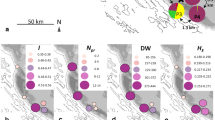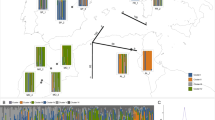Abstract
The dry forests of New Caledonia are an exceptional ecosystem because of their numerous endemic botanical species and their highly diversified fauna of insects, mollusks, reptiles and birds. Unfortunately, the area of the dry forests has been significantly reduced, mainly by human activities. Ecological, phenological and genetic analysis of Ixora margaretae, a symbolic species of the sclerophyll forest, has revealed contrasting traits among natural stands. The division of the natural range and then the separation of forest islands has greatly reduced the existing genetic variability of this species. The genetic diversity is strongly structured in genetic clusters which correspond well to specific ecotypes according to the environmental conditions and the forest types. Furthermore, genetic analysis of the reproductive and non-reproductive trees as well the half-sib families obtained by complete protection of mother trees has revealed substantial genetic drift which has resulted in increased loss of allelic variability. The total consumption of seeds by mainly rats confirms the observed absence of natural regeneration. All these results show that measures taken to protect the stands of dry forests will not be enough to maintain sufficient genetic variability of I. margaretae populations in the long term. Assisted regeneration with control of the increase in variability will be necessary to maintain the biodiversity of the species. The results obtained for I. margaretae must be confirmed with other symbolic species in order to take the necessary measures for the effective preservation of the dry forests in New Caledonia.







Similar content being viewed by others
References
Aldrich PR, Hamrick JL, Chavarriaga P, Kochert G (1998) Microsatellite analysis of demographic genetic structure in fragmented populations of the tropical tree Symphonia globulifera. Mol Ecol 7(8):933–944
Ariyarathna HACK, Gunasekare MTK, Kottawa-Arachchige JD, Paskarathevan R, Ranaweera KK, Ratnayake M, Kumara JBDAP (2011) Morpho-physiological and phenological attributes of reproductive biology of tea (Camellia sinensis (L.) O. Kuntze) in Sri Lanka. Euphytica 181(2):203–215. doi:10.1007/s10681-011-0399-9
Assoumane AA (2006) Etude génétique et écologique d'une espèce menacée de forêt sèche en Nouvelle Calédonie: Captaincookia margaretae. Implications pour sa conservation. Université Pierre et Marie Curie Paris. Master Pro II Parcours Génétique et Gestion de la Biodiversité, 1–40
Assoumane AA, Vaillant A, Mayaki AZ, Verhaegen D (2009) Isolation and characterization of microsatellite markers for Acacia senegal (L.) Willd., a multipurpose arid and semi-arid tree. Mol Ecol Resour 9(5):1380–1383
Ayelea TB, Gailinga O, Finkeldey R (2011) Assessment and integration of genetic, morphological and demographic variation in Hagenia abyssinica (Bruce) J.F. Gmel to guide its conservation. J Nat Conserv 19(1):8–17. doi:10.1016/j.jnc2010.03.001
Barré N, Gay D, Desmoulins F, Selmaoui N (2008) Fragmentation of New-Caledonian dry forests reduces bird diversity. Programme de Conservation des Forêts Sèches, 1–30
Belkhir K, Borsa P, Chikhi L, Raufaste N, Bonhomme F (1996–2004) GENETIX 4.05, logiciel sous Windows TM pour la génétique des populations. Laboratoire Génome, Populations, Interactions, CNRS UMR 5171, Université de Montpellier II, Montpellier (France). Available at http://www.genetix.univ-montp2.fr/genetix/genetix.htm
Billotte N, Lagoda PJL, Risterucci AM, Baurens FC (1999) Microsatellite-enriched librairies: applied methodology for the development of SSR markers in tropical crops. Fruits 54:277–288
Bouchet P, Jaffré T, Veillon J-M (1995) Plant extinction in New Caledonia: protection of sclerophyll forests urgently needed. Biodivers Conserv 4(4):415–428
Callen DF, Thompson AD, Shen Y, Phillips HA, Richards RI, Mulley JC, Sutherland GR (1993) Incidence and origin of "null" alleles in the (AC)n microsatellite markers. Am J Hum Genet 52(5):922–927
Collectif (2002) Le programme Forêt sèche. Available at http://www.foretsechenc/index.htm
Copyright Addinsoft (1995–2007) XLSTAT Version 2007.8.04. Available at http://www.xlstat.com
Corander J, Marttinen P (2006) Bayesian identification of admixture events using multilocus molecular markers. Mol Ecol 15(10):2833–2843
Crandall KA, Bininda-Emonds ORP, Mace GM, Wayne RK (2000) Considering evolutionary processes in conservation biology. Trends Ecol Evol 15(7):290–295
Dutech C, Joly HI, Jarne P (2004) Gene flow, historical population dynamics and genetic diversity within French Guianan populations of a rainforest tree species, Vouacapoua americana. Heredity 92(2):69–77. doi:10.1038/sj.hdy.6800384
El Mousadik A, Petit RJ (1996) High level of genetic differentiation for allelic richness among populations of the argan tree [Argania spinosa (L.) Skeels] endemic to Morocco. Theor Appl Genet 92(7):832–839
England PR, Usher AV, Whelan RJ, Ayre DJ (2002) Microsatellite diversity and genetic structure of fragmented populations of the rare, fire-dependent shrub Grevillea macleayana. Mol Ecol 11(6):967–977
Excoffier L, Laval G, Schneider S (2007) Arlequin ver 3.11: an integrated software package for population genetics data analysis. Computanional and Molecular Population Genetics Lab, Institute of Zoology University of Berne Switzerland, distributed by the authors at http://lgb.unige.ch/arlequin/
Favreau B, Andrianoelina O, Nunez P, Vaillant A, Ramamonjisoa L, Danthu P, Bouvet J-M (2007) Characterization of microsatellite markers in the rosewood (Dalbergia monticola Bosser & R. Rabev.). Mol Ecol Notes 7(5):774–776
Fofana IJ, Ofori D, Poitel M, Verhaegen D (2009) Diversity and genetic structure of teak (Tectona grandis L.f) in its natural range using DNA microsatellite markers. New For 37(2):175–195. doi:10.1007/s11056-008-9116-5
Gillespie TW, Jaffré T (2003) Tropical dry forests in New Caledonia. Biodivers Conserv 12(8):1687–1697
Goudet J (2001) FSTAT, a program to estimate and test gene diversities and fixation indices. Version 2.9.3. Department of Ecology & Evolution, Biology Building, UNIL, CH-1015 Lausanne, Switzerland, distributed by the authors at http://www2.unil.ch/popgen/softwares/fstat.htm
Guillot G, Mortier F, Estoup A (2005) Geneland: a computer package for landscape genetics. Mol Ecol Notes 5(3):712–715
Hallé N (1973) Captaincookia, a new monotypic New Caledonian genus of Rubiaceae, Ixoreae. Adansonia Sér 2(13):195–202
Hardy OJ, Vekemans X (2002) SPAGeDi: a versatile computer program to analyse spatial genetic structure at the individual or population levels. Mol Ecol Notes 2(4):618–620
Hequet V (2010) Ixora margaretae. In: IUCN 2011 IUCN Red List of Threatened Species
Hurlbert SH (1971) The nonconcept of species diversity: a critique and alternative parameters. Ecology 52(4):577–586
Jaffré T (2003) Les groupements végétaux de la forêt sèche. Available at http://www.foretsechenc/index.htm
Jaffré T, Veillon J-M (eds) (1994) Les principales formations végétales autochtones en Nouvelle-Calédonie: caractéristiques, vulnérabilité, mesures de sauvegarde, vol 2. Rapports de Synthèses. Sciences de la Vie. Biodiversité, ORSTOM edn. ORSTOM, Centre de Nouméa
Jaffré T, Morat P, Veillon J-M (1994) La Flore Caractéristiques et composition floristique des principales formations végétales. Bois For Trop 242:7–30
Jaffré T, Morat P, Veillon J-M, Rigault F, Dagostini G (2001) Composition and characteristics of the native flora of New Caledonia. Doc Sci Tech II4:1–138
Kalinowski ST, Taper ML, Marshall TC (2007) Revising how the computer program CERVUS accomodates genotyping error increase sucess in paternity assigment. Mol Ecol 16(5):1099–1106
Kier G, Kreft H, Lee TM, Jetz W, Ibisch PL, Nowicki C, Mutke J, Barthlott W (2009) A global assessment of endemism and species richness across island and mainland regions. Proc Natl Acad Sci USA 106(23):9322–9327. doi:10.1073/pnas.0810306106
Kurata K, Jaffré T, Setoguchi H (2008) Genetic diversity and geographical structure of the pitcher plant Nepenthes vieillardii in New Caledonia: a chloroplast DNA haplotype analysis. Am J Bot 95(12):1632–1644
Lacy RC (1997) Importance of genetic variation to the viability of mammalian populations. J Mammal 78(2):320–335
Loiselle BA, Sork VL, Nason J, Graham C (1995) Spatial genetic structure of a tropical understory shrub, Psychotria officinalis (Rubiaceae). Am J Bot 82(11):1420–1425
Morand M-E, Brachet S, Rossignol P, Dufour J, Frascaria-Lacoste N (2002) A generalized heterozygote deficiency assessed with microsatellites in French common ash populations. Mol Ecol 11(3):377–385
Mouly A, Razafimandimbison SG, Florence J, Jérémie J, Bremer B (2009a) Paraphyly of Ixora and new tribal delimitation of Ixoreae (Rubiaceae): inference from combined chloroplast (rps16, rbcL, and trnT-F) sequence data. Ann Mo Bot Gard 96(1):146–160
Mouly A, Razafimandimbison SG, Khodabandeh A, Bremer B (2009b) Phylogeny and classification of the species-rich pantropical showy genus Ixora (Rubiaceae-Ixoreae) with indications of geographical monophyletic units and hybrids. Am J Bot 96(3):686–706. doi:10.3732/ajb.0800235
Myers N (2003) Biodiversity hotspots revisited. Biosci 53(10):916–917
Myers N, Mittermeier RA, Mittermeier CG, da Fonseca GAB, Kent J (2000) Biodiversity hotspots for conservation priorities. Nature 403:853–858
Ndiade-Bourobou D, Vaillant A, Favreau B, Gayrin E, Bouvet J-M (2009) Isolation and characterization of 15 nuclear microsatellite markers for Baillonella toxisperma Pierre (Sapotaceae), a low-density tree species of Central Africa. Mol Ecol Resour 9(4):1135–1272
Nei M (1978) Estimation of average heterozygosity and genetic distance from a small number of individuals. Genet 89(3):583–590
Newton AC, Allnutt TR, Gillies ACM, Lowe AJ, Ennos RA (1999) Molecular phylogeography, intraspecific variation and the conservation of tree species. Trends Ecol Evol 14(4):140–145. doi:10.1016/S0169-5347(98)01555-9
Noe S (2009) Etude des flux de gènes chez Captaincookia margaretae. Implications pour sa conservation. Master II Biologie Fonctionnelle des Plantes, Université Montpellier 2, 1–19
Perrier X, Jacquemoud-Collet JP (2006) DARwin software. Cirad-Bios UPR Genetic Improvement of Vegetatively Propagated Crops, distributed by the authors at (http://darwin.cirad.fr/darwin)
Pinto CA, Henriques MO, Figueiredo JP, David JS, Abreu FG, Pereira JS, Correia I, David TS (2011) Phenology and growth dynamics in Mediterranean evergreen oaks: effects of environmental conditions and water relations. For Ecol Manag 262(3):500–508. doi:10.1016/j.foreco.2011.04.018
Read J, Sanson GD, de Garine-Wichatitsky M, Jaffré T (2006) Sclerophylly in two contrasting tropical environments: low nutrients vs. low rainfall. Am J Bot 93(11):1601–1614
Read J, Sanson GD, Caldwell E, Clissold FJ, Chatain A, Peeters P, Lamont BB, De Garine-Wichatitsky M, Jaffré T, Kerr S (2009) Correlations between leaf toughness and phenolics among species in contrasting environments of Australia and New Caledonia. Ann Bot 103(5):757–767
Rice WR (1989) Analysing tables of statistical tests. Evolution 43(1):223–225
Rigault F, Dagostini G (2004) Caractérisation floristique et physionomique de la forêt sèche de Nékoro. Programme de Conservation des Forêts Sèches, 1–27
Ritland K (1996) Estimators for pairwise relatedness and individual inbreeding coefficients. Genet Res 67(2):175–185
Rossetto M, Slade RW, Baverstock PR, Henry RJ, Lee LS (1999) Microsatellite variation and assessment of genetic structure in tea tree (Melaleuca alternifolia – Myrtaceae). Mol Ecol 8(4):633–643
Saghai-Maroof MA, Soliman KM, Jorgensen RA, Allard RW (1984) Ribosomal DNA spacer length polymorphisms in barley: Mendelian inheritance, chromosomal location, and population dynamics. Proc Natl Acad Sci USA 81:8014–8018
Serret J (2007) Etude de la diversité génétique de Captaincookia margaretae, espèce endémique des forêts sèches de Nouvelle Calédonie. Licence Professionnelle "Génie des Biotechnologies Végétales", Université Paul Sabatier Toulouse III, 1–28
Thioulouse J, Chessel D, Dolédec S, Olivier JM (1997) ADE-4: a multivariate analysis and graphical display software. Stat Comput 7:75–83
Wünsch A, Hormazaa JI (2002) Molecular characterisation of sweet cherry (Prunus avium L.) genotypes using peach [Prunus persica (L.) Batsch] SSR sequences. Heredity 89(1):56–63. doi:10.1038/sj.hdy.6800101
Acknowledgements
We are most grateful to the Dry Forest Conservation Program, which works on the conservation of dry forests and which supported this study. Collecting permits were kindly provided by the Direction de l’Environnement de la Province Sud and by the Direction du Développement Economique et de l’Environnement de la province Nord. We are indebted to the private owners for granting access to their properties. Our thanks also go to the New Caledonian Agronomic Institute for its support for the collection of samples, for work at the tree nursery and for funding this study (agreement IAC-Cirad N24/2005/CP).
Data Archiving Statement
All ecological and genetic data has been submitted to Dryad under the following DOIs:
Data package title: Data from: Structure and genetic diversity of Ixora margaretae an endangered species: a baseline study for conservation and restoration of natural dry forest of New Caledonia Provisional DOI: doi:10.5061/dryad.76nv3 Data files: Ecological data Data package title:
Data from: Structure and genetic diversity of Ixora margaretae an endangered species: a baseline study for conservation and restoration of natural dry forest of New Caledonia Provisional DOI: doi:10.5061/dryad.707r1 Data files: SSR Data
Author information
Authors and Affiliations
Corresponding author
Additional information
Communicated by M. Byrne
Electronic supplementary material
Below is the link to the electronic supplementary material.
ESM 1
(DOC 31 kb)
Rights and permissions
About this article
Cite this article
Verhaegen, D., Assoumane, A., Serret, J. et al. Structure and genetic diversity of Ixora margaretae an endangered species. Tree Genetics & Genomes 9, 511–524 (2013). https://doi.org/10.1007/s11295-012-0575-7
Received:
Revised:
Accepted:
Published:
Issue Date:
DOI: https://doi.org/10.1007/s11295-012-0575-7




